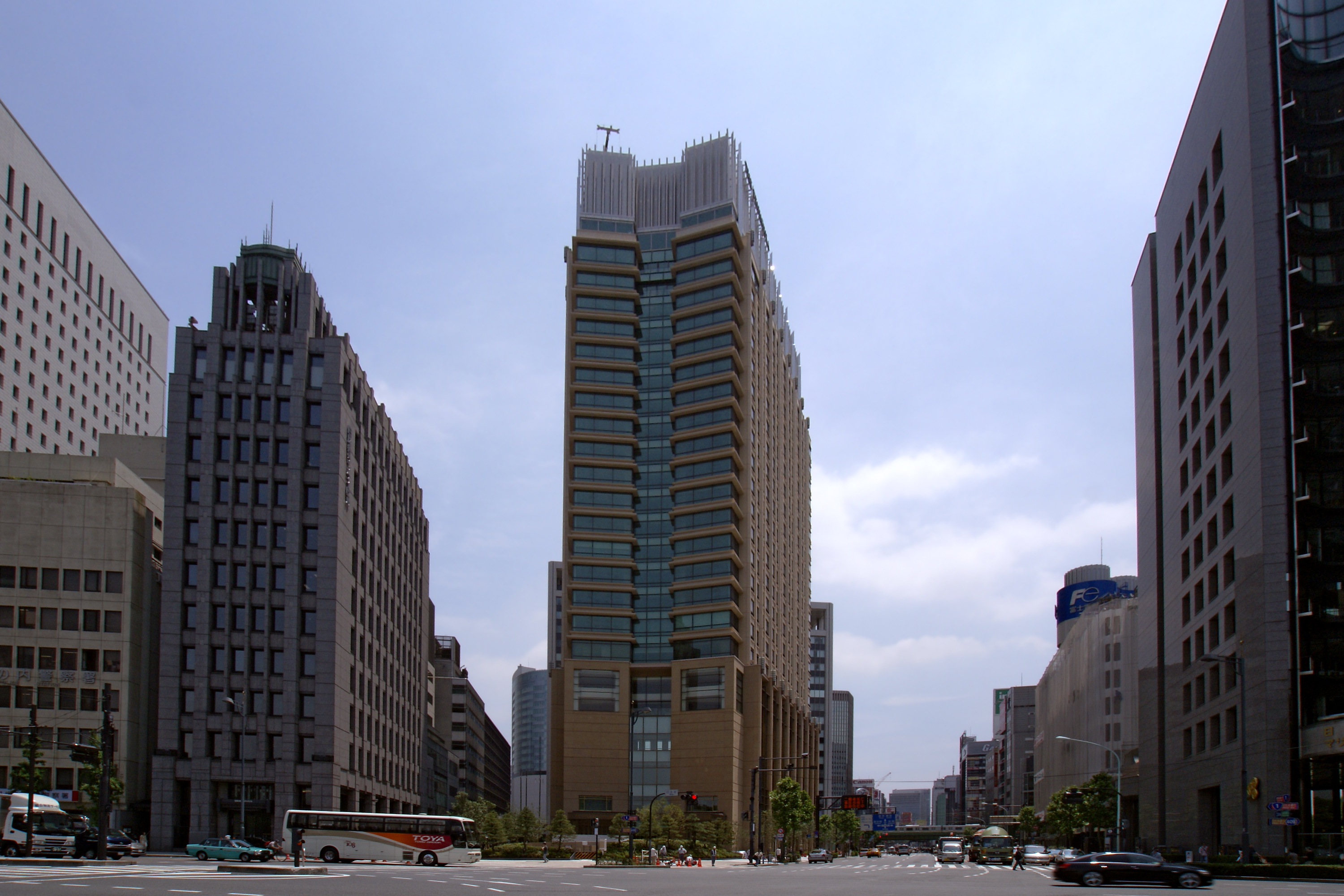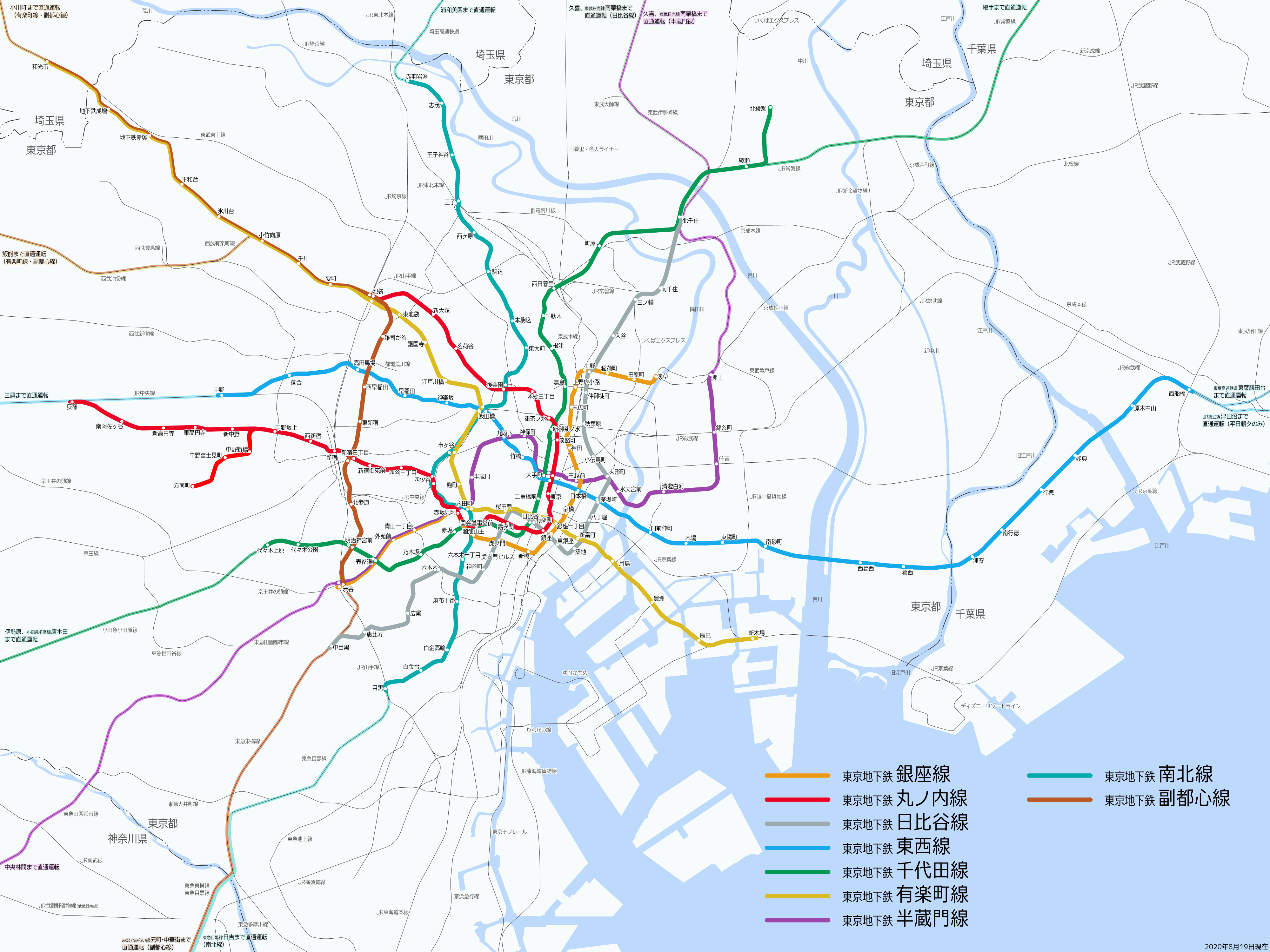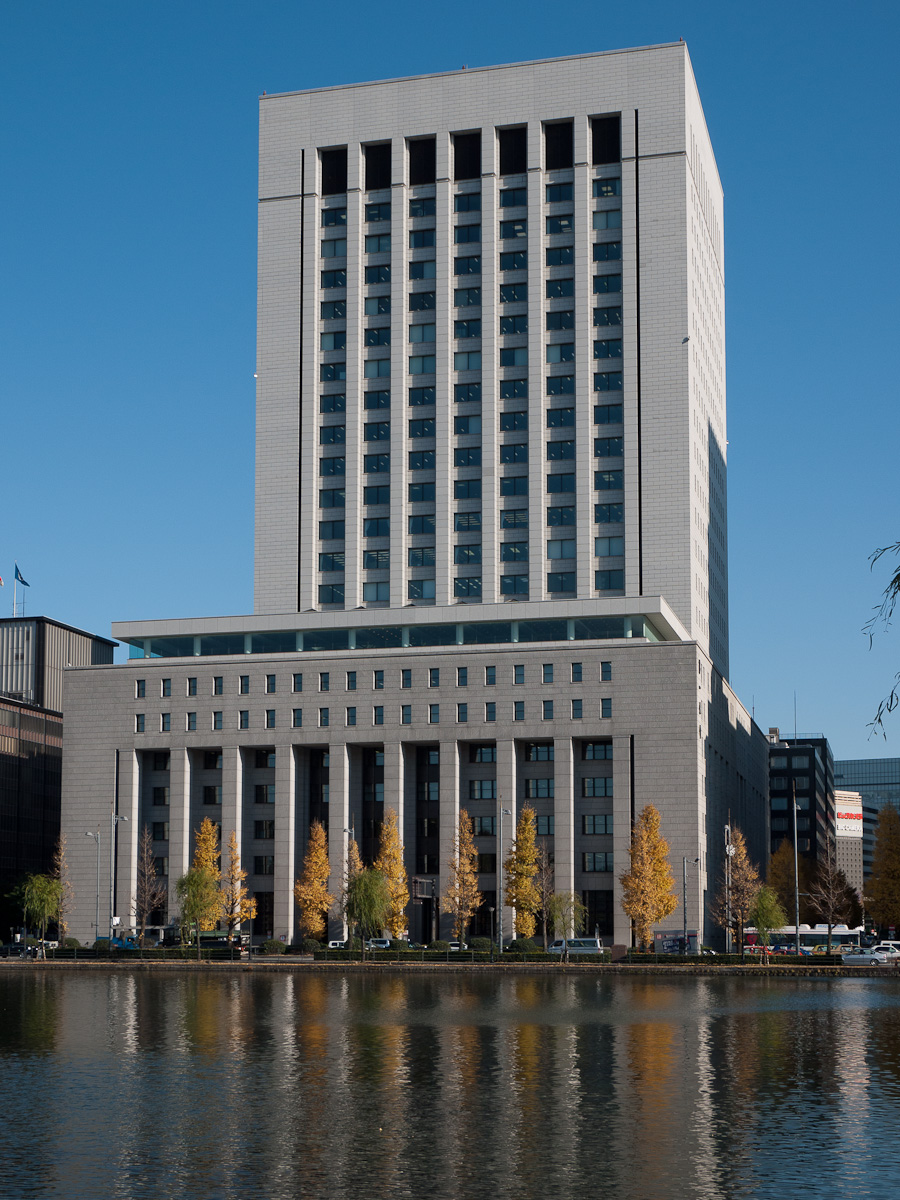|
Hibiya
is a colloquial name for a neighborhood of Chiyoda, Tokyo, Chiyoda Ward in Tokyo. The area along Hibiya Street (Japan National Route 1, National Route 1) from Yūrakuchō to Uchisaiwaichō is generally considered Hibiya district. Administratively, it is part of the Yūrakuchō district. There is no actual administrative district in Chiyoda called "Hibiya" but the name is used in some local place names such as Hibiya Park and Hibiya Station (administratively in Yūrakuchō). Hibiya was part of the old Kōjimachi ward in Tokyo City, before it was transformed into a metropolis. Etymology The outskirts of this district are land reclamation, reclaimed from the ocean, and the "hibi" of Hibiya is derived from the facility for the laver of nori made of bamboo, whose name is also "hibi". This effectively makes the word an ateji, kanji characters used to phonetically represent native Japanese words. History Originally an inlet of the sea ran northwards to a cove at present-day Hi ... [...More Info...] [...Related Items...] OR: [Wikipedia] [Google] [Baidu] |
Hibiya Station
is a Tokyo subway station in the Yūrakuchō district of Chiyoda, Tokyo, Japan, operated by Tokyo Metro and Toei. The area around the station is generally called Hibiya, which is the southwestern corner of the Yūrakuchō district. Hibiya is Tokyo Metro's 33rd busiest station in fiscal 2019, while its connected station Yūrakuchō ranks sixteenth. Lines * Tokyo Metro Chiyoda Line (C-09) * Tokyo Metro Hibiya Line (H-08) * Toei Mita Line (I-08) Yūrakuchō Station on the Tokyo Metro Yūrakuchō Line is connected to Hibiya Station by underground passageways, and it is possible to connect between the two stations without going through the ticket gates. However, the JR platforms at Yūrakuchō are fairly far from Hibiya Station and require a second ticket. Station layout Tokyo Metro platforms Toei platforms File:Tokyo-Metro Hibiya-STA Platform1.jpg, Hibiya Line platforms, 2023 File:Tokyo-Metro Hibiya-STA Platform3-4.jpg, Chiyoda Line platforms, 2023 File:Toei-subway-I08-Hi ... [...More Info...] [...Related Items...] OR: [Wikipedia] [Google] [Baidu] |
Tokyo Metro Hibiya Line
The is a subway line in Tokyo, Japan, owned and operated by Tokyo Metro. The line was named after the Hibiya area in Chiyoda, Tokyo, Chiyoda's Yurakucho district, under which it passes. On maps, diagrams and signboards, the line is shown using the color silver, and its stations are given numbers using the letter "H". Overview The Hibiya Line runs between in Meguro, Tokyo, Meguro and in Adachi, Tokyo, Adachi. The line's path is somewhat similar to that of the Ginza Line; however, the Hibiya Line was designed to serve a number of important districts, such as Ebisu, Shibuya, Ebisu, Roppongi, Tsukiji, Kayabachō and Senju, which were not on an existing line. The Hibiya Line became the first line operated by Tokyo Metro to offer through train, through services with a private railway, and the second Tokyo subway line overall after the Toei Asakusa Line. It is connected to the Tobu Skytree Line at , and through services operate between Naka-Meguro and on the Tobu Skytree Line, an ... [...More Info...] [...Related Items...] OR: [Wikipedia] [Google] [Baidu] |
Hibiya01s3200
is a colloquial name for a neighborhood of Chiyoda Ward in Tokyo. The area along Hibiya Street ( National Route 1) from Yūrakuchō to Uchisaiwaichō is generally considered Hibiya district. Administratively, it is part of the Yūrakuchō district. There is no actual administrative district in Chiyoda called "Hibiya" but the name is used in some local place names such as Hibiya Park and Hibiya Station (administratively in Yūrakuchō). Hibiya was part of the old Kōjimachi ward in Tokyo City, before it was transformed into a metropolis. Etymology The outskirts of this district are reclaimed from the ocean, and the "hibi" of Hibiya is derived from the facility for the laver of nori made of bamboo, whose name is also "hibi". This effectively makes the word an ateji, kanji characters used to phonetically represent native Japanese words. History Originally an inlet of the sea ran northwards to a cove at present-day Hibiya and Kokyo Gaien plaza, into which the Kanda River ... [...More Info...] [...Related Items...] OR: [Wikipedia] [Google] [Baidu] |
Hibiya Park
Hibiya Park (, ) is a park in Chiyoda, Tokyo, Japan. It covers an area of 161,636.66 m2 (40 acres) between the east gardens of the Kōkyo, Imperial Palace to the north, the Shinbashi district to the southeast and the Kasumigaseki government district to the west. History Originally an inlet of the sea ran northwards to a cove at present-day Hibiya and Kokyo Gaien National Garden, Kokyo Gaien plaza, into which the Kanda River flowed. During the rule of the shogun Tokugawa Hidetada, the river was diverted to flow into the Sumida River, with the spoil from the diversion used to reclaim the cove at Hibiya. The land was occupied by the estates of the Mōri clan and Nabeshima clan during the Edo period. It was used for army maneuvers during the Meiji period. It was converted to a park and opened to the public on June 1, 1903. On September 5, 1905, a protest at the park against the Treaty of Portsmouth, which ended the Russo-Japanese War (1904−1905), erupted into the Hibiya incendiar ... [...More Info...] [...Related Items...] OR: [Wikipedia] [Google] [Baidu] |
Tokyo Midtown Hibiya
is a 190,000-square-meter (2.0 million sq ft) mixed-use development in Yurakucho, Tokyo, Japan. Completed in March 2018, the project includes office, commercial, and dining and entertainment facilities. Overview The project site overlooks Hibiya Park on a site previously occupied by the Sanshin Building (1930) and the Hibiya Mitsui Building (1960), the latter having been the head office of Mitsui Bank then of Sumitomo Mitsui Financial Group. The primary developer was Mitsui Fudosan, working in concert with several partners. The same developer owned and operated the larger Tokyo Midtown (東京ミッドタウン) multipurpose project in Tokyo’s Roppongi neighbourhood. The building’s concave glass exterior facing Hibiya Park produces noticeable solar glare onto the streets immediately to the south of the building echoing one of the design flaws of London’s 20 Fenchurch Street skyscraper. Tokyo Midtown Hibiya Atrium 201806.jpg, Atrium Tokyo Midtown Hibiya B1 Hibiya Avenu ... [...More Info...] [...Related Items...] OR: [Wikipedia] [Google] [Baidu] |
Chiyoda, Tokyo
, known as Chiyoda City in English, ." ''City of Chiyoda''. Retrieved on December 28, 2008. is a Special wards of Tokyo, special ward of Tokyo, Japan. Located in the heart of Tokyo's 23 special wards, Chiyoda consists of Tokyo Imperial Palace, the Imperial Palace and a surrounding radius of about a kilometer (1000 yards), and is known as the political and financial center of Japan. As of October 2020, the ward has a population of 66,680, and a population density of 5,709 people per km2 (14,786 per sq. mi.), making it by far the least populated of the special wards. The residential part of Chiyoda is at the heart of Yamanote and Shitamachi, Yamanote, Tokyo's traditional upper-class residential area, with Banchō, Kōjimachi, and Kioichō, Chiyoda, Tokyo, Kioichō considered the most exclusive neighbourhoods in the entire city. ... [...More Info...] [...Related Items...] OR: [Wikipedia] [Google] [Baidu] |
Hibiya Incendiary Incident
The , also known as the Hibiya riots, was a major riot that occurred in Tokyo, Japan, from 5 to 7 September 1905. Protests by Japanese nationalists in Hibiya Park against the terms of the Treaty of Portsmouth ending the Russo-Japanese War escalated into a violent two-day citywide riot when the police attempted to suppress the protests. The Hibiya incendiary incident resulted in the death of 17 rioters, led to the collapse of the government of Katsura Tarō, and is considered the first event of the Era of Popular Violence. Over 2000 rioters were later arrested for their involvement, with 104 being tried and 87 found guilty. Background The Japanese Empire and the Russian Empire fought the Russo-Japanese War from February 1904 to September 1905 after decades of growing tensions over competing imperialist interests in Northeast Asia. Although the Imperial Japanese Navy had decisively defeated the Imperial Russian Navy at the Battle of Tsushima, and the Imperial Japanese Army had tak ... [...More Info...] [...Related Items...] OR: [Wikipedia] [Google] [Baidu] |
Tokyo Metro
The Tokyo Metro () is a major rapid transit system in Tokyo, Japan, operated by the #Organization, Tokyo Metro Co. With an average daily ridership of 6.52 million passengers (as of 2023), the Tokyo Metro is the larger of the Tokyo subway, two subway operators in the city, the other being the Toei Subway, with 2.85 million average daily rides. Organization Tokyo Metro is operated by , a joint-stock company jointly owned by the Government of Japan and the Tokyo Metropolitan Government. The company, founded as a part of then-Prime Minister Junichiro Koizumi's policy of converting statutory corporations into Joint-stock company, joint-stock companies, replaced the , commonly known as Eidan or TRTA, on April 1, 2004. TRTA was administered by the Ministry of Land, Infrastructure and Transport (Japan), Ministry of Land, Infrastructure and Transport, and jointly funded by the national and metropolitan governments. It was formed in 1941 as a part-nationalization of the Tokyo Undergrou ... [...More Info...] [...Related Items...] OR: [Wikipedia] [Google] [Baidu] |
Yūrakuchō
is a business district of Chiyoda, Tokyo, Japan, situated in between the Ginza and Hibiya Park, southeast of the Tokyo Imperial Palace. The district takes its name from Oda Nagamasu (1547–1622), who was also known as Yūraku (有楽). Oda Nagamasu built his mansion here on land granted by Tokugawa Ieyasu near the Sukiya-bashi Gate of Edo Castle. The place name dates from the Meiji period. Yūrakuchō is served by several train and subway stations, including Hibiya Station (Toei Subway and Tokyo Metro lines) and Yūrakuchō Station (JR East and Tokyo Metro lines). Unlike its tonier neighbor Ginza, Yūrakuchō provides a glimpse of Japanese life from the early postwar period, with its many ''izakaya'' (Japanese-style bars, denoted by their red lanterns known as ''Traditional lighting equipment of Japan, akachochin'') and outdoor ''yakitori'' restaurants, many of which are located near or under the train tracks serving Tokyo's Japan Railways Group, JR Yamanote Line. Because of it ... [...More Info...] [...Related Items...] OR: [Wikipedia] [Google] [Baidu] |
Uchisaiwaichō
is a district of Chiyoda, Tokyo, at the south-east corner of the ward bordering with Chūō and Minato. Uchisaiwaichō Station on the Toei Mita Line is located in the area. Parts of the Hibiya Station and Shimbashi Station are also located in the neighborhood. History In the late Edo period, the present-day Uchiwaisaichō area was a part of the Hibiya area. Many ''daimyō''s mansions were located in the area, which was within the outer moat of Edo Castle. After the Meiji Restoration, it was known for a time as before the name "Uchisaiwaichō" was adopted after its location between on the Outer Moat and . The Tokyo National Museum was originally located in the area. Businesses * Amundi Japan *China Airlines * Ernst & Young ShinNihon LLC * Fukoku Mutual Life Insurance * Imperial Hotel * JFE Steel * Kroll Inc. *Mizuho Bank *NTT Communications *Shinsei Bank is a leading diversified Japanese financial institution that provides a full range of financial products and ... [...More Info...] [...Related Items...] OR: [Wikipedia] [Google] [Baidu] |
Imperial Hotel, Tokyo
The is a hotel in Uchisaiwaicho, Chiyoda ward, Tokyo. It was created in the late 1880s at the request of the Japanese aristocracy to cater to the increasing number of Western visitors to Japan. The hotel site is located just south of the Imperial Palace grounds, next to the previous location of the Palace moat. The modern hotel overlooks the Palace, the Hibiya Park, and the Yurakucho and Ginza neighborhoods. In a reference to the three Edo era branch houses of the Tokugawa clan, the Imperial Hotel, Hotel Okura Tokyo, and Hotel New Otani Tokyo are often referred to as one of the of Tokyo. History Three main buildings have stood on the hotel site, each of which embodied the finest Western design of its era. Including annexes, at least 10 structures have been part of the Imperial Hotel, including two designed by Frank Lloyd Wright: * The original Imperial Hotel, designed by Yuzuru Watanabe (1890–1922) * Hotel Metropole in Tsukiji, purchased as an annex (1906–1910) ... [...More Info...] [...Related Items...] OR: [Wikipedia] [Google] [Baidu] |









